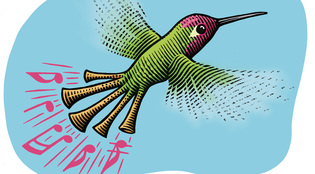 loading
loading
FindingsShake a tail feather Gregory NemecView full image
When a female Anna's hummingbird enters a male's territory during mating season, he puts on a dramatic show to woo her. His courtship display involves repeated high-speed dives over the female's head, each one punctuated with a single loud beep. The beeps are similar to the bird's chirps, and researchers have debated whether they are vocal or somehow produced by its tail feathers. Now postdoctoral associate Christopher Clark has settled the argument. He captured several birds, removed their unusually shaped outer tail feathers, and then watched as previously noisy males dove silently. Then he took the purloined feathers to a wind tunnel, and he was able to reproduce the sounds by holding the feathers in the wind at certain angles. The distinctive courtship beeps, Clark showed, are caused when the feathers flutter at dive speed like flags in a high wind, producing sound waves that reach human (and avian) ears. He's since found that several other species of hummingbirds make noises with their tails. Though few birds make noises as loud and communicative as the Anna's, Clark says he thinks feather sounds are probably quite common, and that many bird species have adapted to recognize the whooshing, whistling, and beeping created by movement of their brethren. He's at work in the wind tunnel to analyze the sound-producing potential of feathers from throughout the bird kingdom. In the case of the Costa's hummingbird, Clark and a coauthor have argued that tail feather noises probably predate the bird's vocal song. Because females evolved a strong response to the sound of the courtship dive, they postulate, the males developed the capacity to make similar sounds in another way. But the specific meaning conveyed by the sound is still a mystery. It could be a signal to females that a male can fly well, that it has healthy feathers, or that it is fully mature. For hummingbird species whose only obvious difference from competing species is different tail feather shapes, says Clark, the noise could signal, "I'm the same species"—and therefore an eligible bachelor. Whatever the reason, females like it. Which is why, when Clark goes to northern Chile to study the endangered Chilean woodstar later this year, he will leave the birds' feathers intact.
The comment period has expired.
|
|